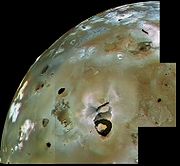
Loki Patera
Encyclopedia

Jupiter
Jupiter is the fifth planet from the Sun and the largest planet within the Solar System. It is a gas giant with mass one-thousandth that of the Sun but is two and a half times the mass of all the other planets in our Solar System combined. Jupiter is classified as a gas giant along with Saturn,...
's moon Io
Io (moon)
Io ) is the innermost of the four Galilean moons of the planet Jupiter and, with a diameter of , the fourth-largest moon in the Solar System. It was named after the mythological character of Io, a priestess of Hera who became one of the lovers of Zeus....
, 202 kilometres (125.5 mi) in diameter. It contains an active lava lake
Lava lake
Lava lakes are large volumes of molten lava, usually basaltic, contained in a volcanic vent, crater, or broad depression. The term is used to describe both lava lakes that are wholly or partly molten and those that are solidified...
, with an episodically overturning crust. The level of activity seen is similar to a superfast spreading mid-ocean ridge
Mid-ocean ridge
A mid-ocean ridge is a general term for an underwater mountain system that consists of various mountain ranges , typically having a valley known as a rift running along its spine, formed by plate tectonics. This type of oceanic ridge is characteristic of what is known as an oceanic spreading...
on Earth. Temperature measurements of thermal emission at Loki Patera taken by Voyager 1
Voyager 1
The Voyager 1 spacecraft is a 722-kilogram space probe launched by NASA in 1977, to study the outer Solar System and eventually interstellar space. Operating for as of today , the spacecraft receives routine commands and transmits data back to the Deep Space Network. At a distance of as of...
Ionian lava lakes such as Loki Patera are depressions partially filled with molten lava covered by a thin solidified crust. These lava lakes are directly connected to a magma reservoir lying below. Observations of thermal emission at several Ionian lava lakes reveal glowing molten rock along the patera margin, caused by the lake's crust breaking up along the edge of the patera. Over time, because the solidified lava is denser than the still-molten magma below, this crust can flounder, triggering an increase in thermal emission at the volcano. At sites such as Loki Patera, this can occur episodically. During an overturning episode, Loki can emit up to ten times more heat than when its crust is stable. During an eruption at these more quiescent lava lakes, a wave of foundering crust spreads out across the patera at the rate of about 1 kilometre (0.621372736649807 mi) per day, until the entire lake crust has been resurfaced. Another eruption would begin once the new crust has cooled and thickened enough for it to no longer be buoyant over the molten lava.
Loki Patera is located at 13°N 308.8°W. It is named after the Norse
Norse mythology
Norse mythology, a subset of Germanic mythology, is the overall term for the myths, legends and beliefs about supernatural beings of Norse pagans. It flourished prior to the Christianization of Scandinavia, during the Early Middle Ages, and passed into Nordic folklore, with some aspects surviving...
god Loki
Loki
In Norse mythology, Loki or Loke is a god or jötunn . Loki is the son of Fárbauti and Laufey, and the brother of Helblindi and Býleistr. By the jötunn Angrboða, Loki is the father of Hel, the wolf Fenrir, and the world serpent Jörmungandr. By his wife Sigyn, Loki is the father of Nari or Narfi...
. Amaterasu Patera
Amaterasu Patera
Amaterasu Patera is a patera, or a complex crater with scalloped edges, on Jupiter's moon Io. Its temperature was estimated on March 5, 1979 to be around 218 kelvins. It is one of the darkest features on Io, and the measurement of its thermal spectrum helped to support an anticorrelation...
is located to the north and Manua Patera
Manua Patera
Manua Patera is a patera, or a complex crater with scalloped edges, on Jupiter's moon Io. It is 110.5 kilometers in diameter and is located at . It is named after the Hawaiian sun god Manua. Its name was adopted by the International Astronomical Union in 1979. To the southwest is Fuchi Patera, and...
to the northwest.

